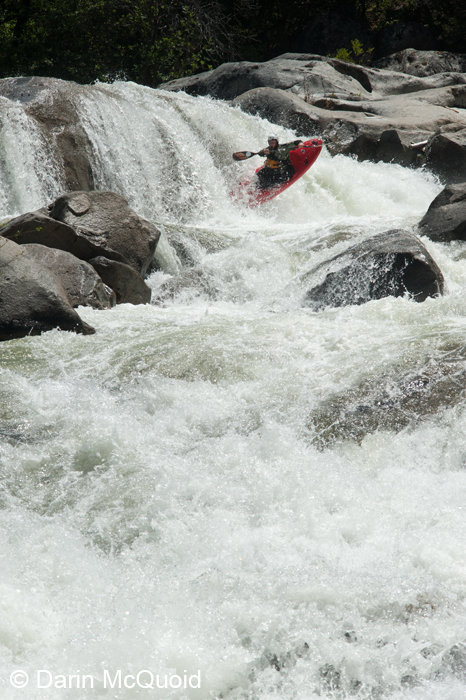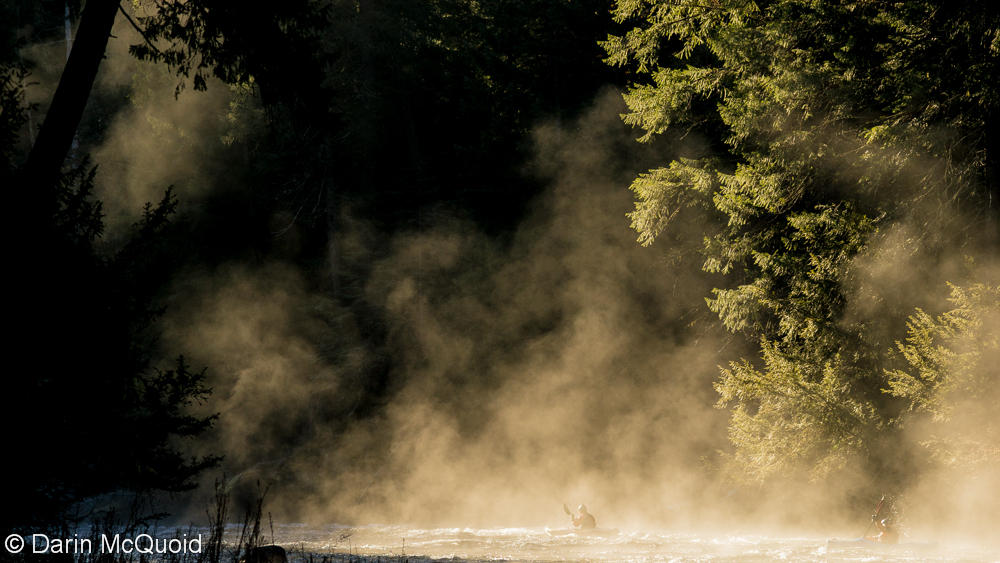
| Darin McQuoid | Blog | Reviews | Tutorials | River Directory |
Whitewater
Photography Tutorial #6: Lighting.
Out of a hundred
plus days a year
on the water I see great light once or twice. Time
and time again people say California has great light for shooting
kayaking. California has easy light for getting an average shot with
the sun directly overhead. Great, dramatic
lighting generally
happens
when the sun is low in the sky. That's part of the reason the hours
around sunrise and
sunset are loved by photographers. Unfortunately for kayaking, we're
generally driving to the river around sunrise and trying to not get
stuck on it as sunset approaches. Combine that with deep canyons and
it's tough to get good light on the river.
The largest
mistake beginners
(myself included) make is to choose
their angle for the rapid, not the light. What looks pleasant to the
eye will often look good to the camera, and what looks harsh to the eye
will certainly look harsh in a photo. Train your eye to see light. The
easiest thing to do at first is just look at where your shadow falls
and try to shoot with the sun at your back.

Nikon D200, Sigma 10-20 @ 20mm 1/1250 F9 ISO 200
If you want to shoot a certain angle of a rapid note the suns position relative to it at different times in the day. To get a certain angle you just have to be there at the right time, and often the right time of year. Below this shot is only available early in the morning and it's typical to be at this location in the afternoon. On this trip we had to hike through snow and ended up camping at the put-in instead of putting on. The unplanned can work well if you pay attention to the opportunities the situation presents.
Early on I thought that sunny days were best for shooting action, since they allow medium apertures, fast shutters and low ISO speeds. Unfortunately they also limit your ability to shoot the angle you want. One of my favorite conditions is when a high cloud cover causes the light to naturally "lightbox". A lightbox is used to disperse light so it's even from all angles, and nature will do this for us from time to time. On these rare days on can shoot from anywhere with nice even lighting.
As a beginning photographer I hated mixed light days. They make it tough for the camera to meter, and I just assumed all sunlight was the ideal lighting conditions. Then I had a motivational poster, an old Pyranha ad shot by Charlie Munsey on Rodgers Creek. Mixed lighting left the bottom of the falls in the shade, giving the feeling that Charlie Beavers was dropping into the unknown. I have the lowest ratio of keepers in mixed lighting, but the ones worth saving make the effort worthwhile. In short, just because the lighting may seem bad, don't write it off.
It's not easy to get out to take a photograph in relative flat water. Don't wait until next time. Good light is rare, seize the opportunity.
Next Up: Composition.
Whitewater Photography Tutorial #1: Intro.
Whitewater Photography Tutorial #2: What is the right exposure?
Whitewater Photography Tutorial #3: Getting the right exposure.
Whitewater Photography Tutorial #4: Low Light Action
Whitewater Photography Tutorial #5: Focus
Whitewater Photography Tutorial #6: Lighting
Whitewater Photography Tutorial #7: Composition
Whitewater Photography Tutorial #8: Wide Angles
Whitewater Photography Tutorial #9: Panning
Whitewater Photography Tutorial #10: Post-processing
Whitewater Photography Tutorial #11: Sequencing
Shooting for the
rapid and into the
sun results in glare, heavy shadows and poor color saturation. Jonas Grunwald on
Dinkey Creek.

Nikon D700, Nikon 75-150mm f/3.5 @ 1/800 F8 ISO 100.

Nikon D700, Nikon 75-150mm f/3.5 @ 1/800 F8 ISO 100.
Shooting for the
light at mid-day.
Ben Coleman on Dinkey Creek.

Nikon D200, Sigma 10-20 @ 20mm 1/1250 F9 ISO 200
If you want to shoot a certain angle of a rapid note the suns position relative to it at different times in the day. To get a certain angle you just have to be there at the right time, and often the right time of year. Below this shot is only available early in the morning and it's typical to be at this location in the afternoon. On this trip we had to hike through snow and ended up camping at the put-in instead of putting on. The unplanned can work well if you pay attention to the opportunities the situation presents.
Laura Farrell on
Dinkey Creek.

Nikon D700, Nikon 75-150mm f/3.5 @ 1/800 f/8 ISO 320

Nikon D700, Nikon 75-150mm f/3.5 @ 1/800 f/8 ISO 320
Early on I thought that sunny days were best for shooting action, since they allow medium apertures, fast shutters and low ISO speeds. Unfortunately they also limit your ability to shoot the angle you want. One of my favorite conditions is when a high cloud cover causes the light to naturally "lightbox". A lightbox is used to disperse light so it's even from all angles, and nature will do this for us from time to time. On these rare days on can shoot from anywhere with nice even lighting.
Lightbox
day! Taylor Cavin on
the South Branch of the Middle Fork Feather.

Nikkor 200mm F4 AIS @ 1/800 F4 ISO 125
Rok Sribar likes
to say "It's
important to be good, but it's more important to be lucky".
It's
true but I believe that “Luck is what happens when
preparation
meets opportunity.” - Seneca.
Nikkor 200mm F4 AIS @ 1/800 F4 ISO 125
Jonas Grunwald on
Fantasy Falls of
the North Fork Mokelumne. This light lasted a minute or two and was
gone.

Nikon D700, Tamron 28-75mm f/2.8 @ 28mm 1/1250 f/8 ISO 200

Nikon D700, Tamron 28-75mm f/2.8 @ 28mm 1/1250 f/8 ISO 200
As a beginning photographer I hated mixed light days. They make it tough for the camera to meter, and I just assumed all sunlight was the ideal lighting conditions. Then I had a motivational poster, an old Pyranha ad shot by Charlie Munsey on Rodgers Creek. Mixed lighting left the bottom of the falls in the shade, giving the feeling that Charlie Beavers was dropping into the unknown. I have the lowest ratio of keepers in mixed lighting, but the ones worth saving make the effort worthwhile. In short, just because the lighting may seem bad, don't write it off.
Daniel Brasuell on
Golden Gate of
the South Fork American

Nikon D200, Nikkor 18-200 @ 18mm 1/640 f/6.3 ISO 400.

Nikon D200, Nikkor 18-200 @ 18mm 1/640 f/6.3 ISO 400.
It's not easy to get out to take a photograph in relative flat water. Don't wait until next time. Good light is rare, seize the opportunity.
Morning
fog on the McCloud River with Nick Sumner and James Mitchell.

Sony A7, Canon FD 135mm f/2 @ 1/1000 f/2.8 ISO 100

Sony A7, Canon FD 135mm f/2 @ 1/1000 f/2.8 ISO 100
Next Up: Composition.
Whitewater Photography Tutorial #1: Intro.
Whitewater Photography Tutorial #2: What is the right exposure?
Whitewater Photography Tutorial #3: Getting the right exposure.
Whitewater Photography Tutorial #4: Low Light Action
Whitewater Photography Tutorial #5: Focus
Whitewater Photography Tutorial #6: Lighting
Whitewater Photography Tutorial #7: Composition
Whitewater Photography Tutorial #8: Wide Angles
Whitewater Photography Tutorial #9: Panning
Whitewater Photography Tutorial #10: Post-processing
Whitewater Photography Tutorial #11: Sequencing
Comment
Box is loading comments...